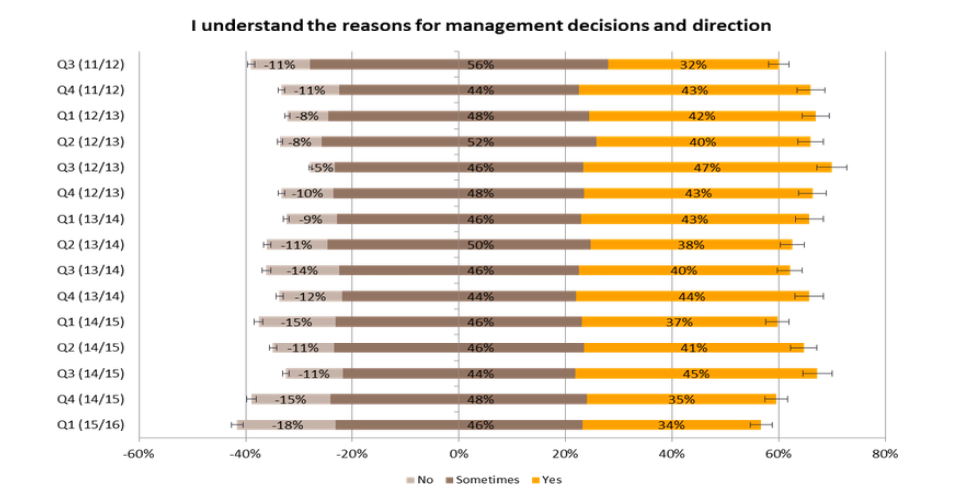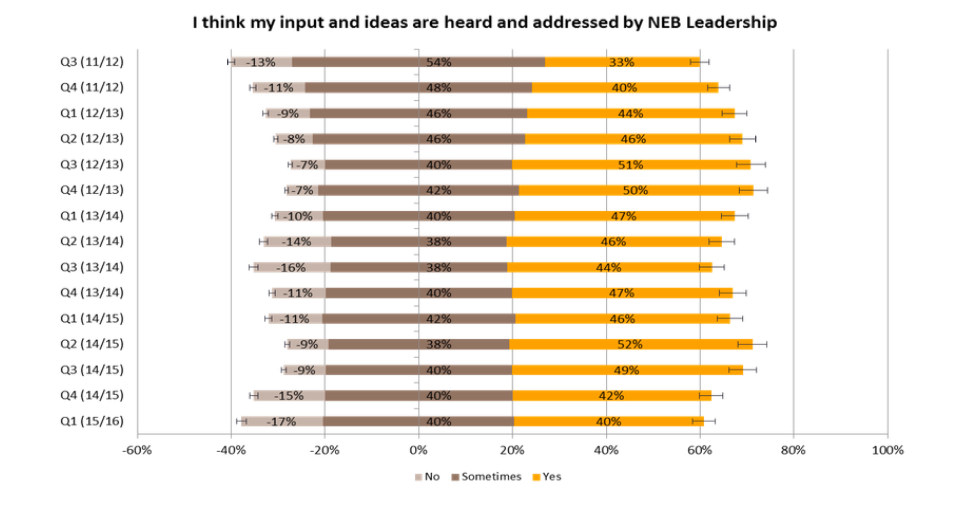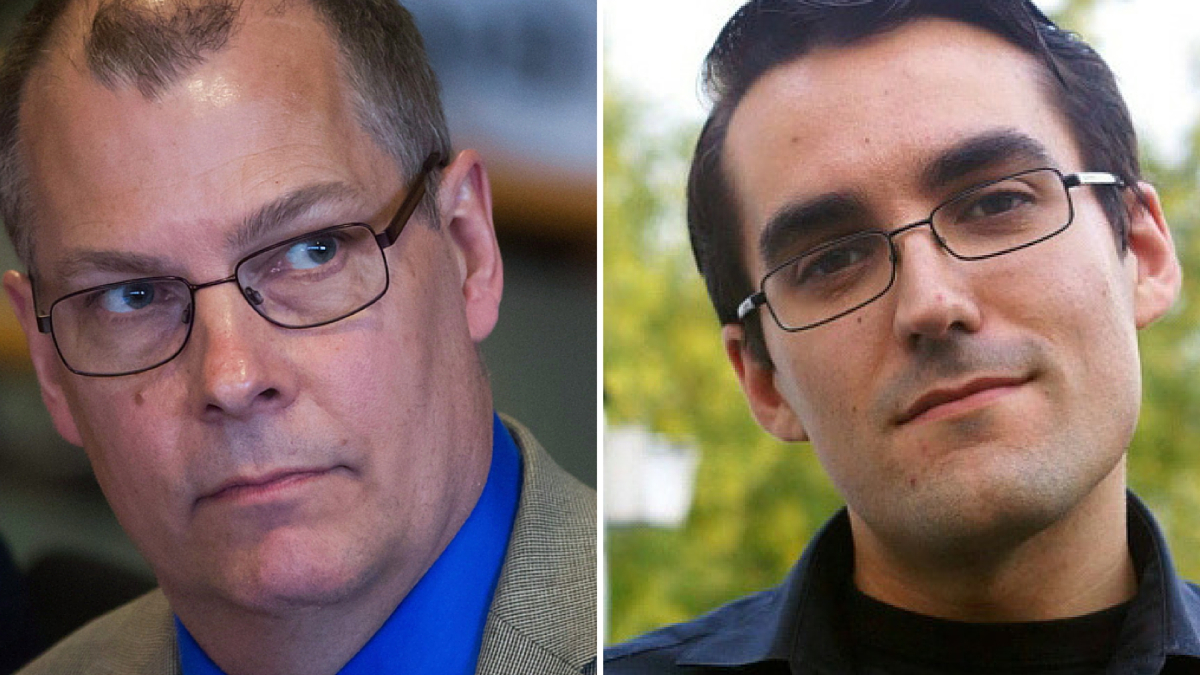Support strong Canadian climate journalism for 2025
While Calgarians donned their cowboy hats and boots to navigate crowds at the Stampede last July, the staff at Canada's pipeline watchdog were faced with a tragedy.
Joshua Burgess had just been arrested and charged with second degree murder after the body of his wife, Shannon Madill, was found at their home. And Burgess, it turned out, worked for the National Energy Board (NEB.)
Most employees at the pipeline watchdog may not have known Burgess and surely none would have guessed whether he harboured a terrible secret in his last months on the job.
But at a time when Prime Minister Justin Trudeau's Liberal government is trying to restore public confidence in the NEB, newly-released emails and internal surveys reviewed by National Observer tell the story of numerous problems inside the watchdog. The documents reveal secrets that management was trying to keep and show just how hard it will be to fix these problems and inspire the trust, both outside the Board and from within.
The NEB employees are losing faith in their bosses, these documents show, and are increasingly frustrated and puzzled by decisions they are instructed to implement. At the same time, internal emails reveal numerous examples of those in management positions taking extra care to massage messages and improve the NEB’s exterior image, in spite of sinking morale inside the Board.
The Liberal government has pledged to modernize the NEB and introduce more regional representation from across Canada to its governing board.
Yet critics inside and outside the organization have told National Observer that with public safety at risk, the government should go much further. They say it's time to completely overhaul the NEB, starting with its management.
Don't wear NEB jackets in public
The fact that Burgess worked for the NEB was not widely known by the general public. But when Burgess was arrested, words rippled through the Board's workforce of about 500 people.
Burgess had appeared with his wife's family at a news conference in December 2014, shortly after she went missing. Together, they pleaded with the public for her safe return. The allegations against Burgess haven't been proven in court and he is scheduled to appear at a preliminary hearing in August.
Calgary police would eventually request and receive the emails Burgess drafted at work right before and after his wife’s disappearance. Meanwhile, he continued his administrative job at the NEB for months until investigators found the concealed body at his home on Friday, July 3, 2015.
That weekend, Merrilee Davies, an acting leader from the NEB’s human resources department, spoke with a crisis counsellor from Homewood Health to discuss the tragedy.
Davies and the counsellor talked about how NEB management could help staff cope. They also discussed how it could avoid negative media coverage.
“Well that was an interesting and educational discussion,” wrote Davies, in a July 5, 2015 email after she spoke with the counsellor.
Davies sent the message to other human resources staff as well as to an NEB executive vice president, Paula Futoransky.
“She really emphasized the importance of proper messaging from a leadership perspective,” Davies continued, in the email. “Finally she recommended that we have a media plan. She said if the media finds out he works for us, there is a good likelihood they will come around to see if people will comment - she went so far as to say we should suggest people not wear NEB jackets or logos. She said she has seen similar situations where people were stopped in lobbies, parking lots, etc.”
The NEB’s chief operating officer, Josée Touchette, would reply a couple of hours later on the Sunday evening writing that she agreed with the advice. No one at the NEB would be allowed to say anything in public about the murder unless their messages were approved in advance by her and NEB lawyers, Touchette wrote in that message.
“I wish to stress that we really have to be careful of what we say and how we say it to staff given the ongoing (criminal) investigation,” Touchette wrote. “Have legal review any comms lines and run them by me as well.”
No news outlet wound up writing about where Burgess had worked, so the NEB succeeded in avoiding the negative media coverage it feared.
Controlling the message
It’s not unusual for any organization or business to develop a plan for staff when faced with a tragedy of this nature. It also wasn't new for the NEB to pay special attention to its image.
In 2014, the regulator’s spin doctors developed a sophisticated three-year communications plan to polish its reputation and boost public confidence in its record.
The National Energy Board employs about 500 employees who work on reviewing major energy project applications, policing pipeline safety as well as researching energy trends. It has full powers of investigation as well as all of the powers of a federal court for areas under its jurisdiction. It can also use its extraordinary powers to enforce decisions or sanctions within the scope of its mandate.
The NEB is governed by politically-appointed members, several of whom were selected by the government of former Conservative Prime Minister Stephen Harper. The three-year communications strategy fits in with a broader plan deployed by the former Harper government to promote Canada’s resources and fossil fuel industries.
The communications plan was also developed around the same time that the former government and the NEB were being criticized by federal Liberals, Indigenous peoples and environmentalists for approving Enbridge Inc.'s proposed Northern Gateway pipeline project. Enbridge had proposed to build a multibillion dollar pipeline between Edmonton, Alberta and Kitimat, British Columbia that would deliver up to 525,000 barrels of oil per day to the coast. But it has not yet met conditions imposed by the NEB and required for it to proceed with construction of the Northern Gateway pipeline.
The strategy document, released through access to information legislation, appeared to be the basis for a cross-Canada tour, led by the NEB chair and chief executive officer Peter Watson, to earn the trust of Canadians in the regulator.
"We have to create and deliver more deliberate, compelling and controlled messages about the work we do," said the NEB communications plan.
Part of the communications strategy was to target key reporters to encourage them to write articles that would “inspire confidence” in the NEB, the document said. The NEB specifically identified specialty media outlets such as the Hill Times, the Daily Oil Bulletin, and Platts Energy among potential targets for it to contact in order to deliver its message.
"We will also take a closer look at what the NEB should be marketing to the media as 'newsworthy' to ensure that any viable strategic opportunity to tell aspects of our story are seized upon, and begin presenting these opportunities to leadership for consideration,” the document said.
The strategy document also recommended that the NEB needed to improve its management of crisis situations. A "community relations" program was recommended as well to focus on building relationships with people to increase public confidence in the regulator overall.
The NEB opened two regional offices last year in Montreal and Vancouver as part of its public relations and community outreach strategy.
But public and internal surveys show that theses efforts have failed.
Connecting dots
More than half of Canadians have little or no confidence in the NEB, according to a recent Ekos poll commissioned by the CBC.
At its headquarters, internal survey results show bad morale in the workplace and mounting frustrations with management.
Chief operating officer Touchette admitted she could see a problem when she first told staff about the troubling survey numbers in May 2015.
“I have reviewed the results and your comments with great interest, as I feel they point to some of the challenges that change often brings to an organization,” wrote Touchette in a message to all staff sent on May 8, 2015. “I would like to assure you that the message is received! I am committed to ramping up my internal communications to better explain the rationale behind some of the activities that are taking place. We have planned upcoming messages to respond to comments in the survey about topics you would like to see more information about.”
Touchette, a veteran senior public servant who joined the NEB in 2015, also wrote in that message that the NEB was pursuing efforts to convince Canadians it was doing a good job.
And she recognized that the NEB’s management would need to improve communications with its staff “to come together and get on the same page.”
“In the meantime, I will continue to work with our senior leadership to ensure that the information staff need to connect some of the dots and navigate the changes around us is clear and forthcoming," she wrote.
Three months later, survey results from the first quarter of 2015 were released to staff, showing that the problem was getting worse.
Only 34 per cent of NEB employees said "yes" to a question asking whether they understood the “reasons for management decisions and direction,” the 2015 survey showed. This was down from a peak in the third quarter of 2012-2013 when 47 per cent of employees said "yes" to the same question.
The survey results also found that nearly one in five employees - or 17 per cent - did not believe their ideas and input were being heard and addressed by NEB leadership. This continued a declining trend in employee morale over the previous year. It also represented a three-fold increase from the third quarter of 2012-2013, when only five per cent of employees said NEB leadership wasn't listening to their ideas and input.

No confidence
The NEB has been doing quarterly surveys of employees since 2011. It usually shares the results with its employees, along with a message from leadership, according to an internal NEB memo dated Jan. 28, 2015.
But the alarming survey results gathered in 2015 prompted management to cancel the quarterly surveys just as the federal election campaign was getting underway in Canada.
The feedback from staff was so negative that the NEB, in response to a request under Canada's access to information law, refused to release copies of anonymous comments from employees that were gathered in the surveys.
“While the results tell us, as leaders, that we have work to do, we all agree that we appreciate the clarity and focus of the feedback you have offered,” NEB chairman and CEO Peter Watson told the staff in a message on Aug. 6, 2015. “I want to assure staff that we have heard you, in both this quarter’s results and in the last quarter as well. Change is never easy in any organization. There are always things that leaders can do more of to make sure that staff understand why changes are happening, what those changes mean for all members of our staff, and what the critical next steps will be.”
Watson continued by writing that the NEB leadership would focus on finding a way to demonstrate to Canadians that it was competent and had a comprehensive approach to ensuring public safety and protecting the environment.

After a series of focus group and town hall discussions, the NEB ultimately decided to hire consultants from Ernst and Young, awarding the firm a contract worth $522,206 to fix its management problem.
The energy board's spokesman Craig Loewen said that the NEB planned to resume the employee surveys at some point in the future, but he defended the Ernst and Young contract, explaining that it was the right solution.
“We believe this to be a best practice,” Loewen told National Observer. “Reviewing and updating (how we operate) ensures that the NEB’s administration remains effective to support its work as Canada’s national energy regulator.”
The NEB issued the contract discreetly, ensuring that the public would not find out about it until after it was awarded.
The regulator did this by using a special procurement tool that allows federal organizations to only invite pre-selected firms to bid on contracts. In this case, the NEB invited only Ernst and Young and Modis Canada to bid on the contract.
When a government organization offers a contract using this type of procurement tool, it doesn’t have to publicly post the invitation.
The contract invitation, released in response to another access to information request, appeared to be rushed. It misspelled the word “plan” in a section that outlined the scope of the work. The description of the work was also vague, neglecting to mention the disastrous employee survey results.
Execs spend $1 million on furniture
The Ernst and Young contract was not the only unusual spending by the NEB in recent years.
Senior management approved spending about $21 million over two years in 2013 and 2014 to move its headquarters a few blocks away from its old offices in downtown Calgary.
After they moved their furniture and supplies, the regulator paid a local supplies firm almost $1 million to refit the offices of senior managers and executives with brand new furniture.
But the NEB told Parliament that it was cutting back anticipated spending that was meant to improve its safety oversight, and was instead using more money for marketing and public relations.
In its last available annual performance report, tabled in Parliament, the NEB said that it had cut its anticipated spending on safety oversight measures such as inspections and the development of regulations by about $17 million in 2014-2015. The report also estimated that it spent about $14 million more than it had planned to spend on internal services such as communications or public relations for the year.
To put these numbers in context, the NEB has told Parliament it plans to spend about $94 million on operations over the next year.
While most of the funding for the NEB is recovered from fees paid by industry, the regulator is still required to follow federal rules for government spending.
In each of the cases related to its Calgary move and the furniture purchases, the NEB has said it followed government rules and obtained the required approvals prior to spending money.
But some former and current employees still believe that the NEB operates a bit differently than other federal departments and agencies. Its management doesn’t always do the right thing, they allege.
“It is the pay grade of the individual that decides what is right or wrong (at the NEB) and that is not a typical government of Canada approach,” said a retired NEB employee who asked not to be named.
"Funny decisions"
Technical staff, responsible for overseeing federally-regulated pipelines and ensuring that they don't leak, spill or explode, have also expressed concerns with senior management.
As reported by National Observer last week, Doug Ochitwa, one of the technical experts who worked on an NEB probe of Enbridge’s control room in the wake of a major 2010 leak into the Kalamazoo River in Marshall, Michigan, said he would rather work for industry.
“The pay is poor,” Ochitwa wrote in a text message sent to an industry whistleblower on Sept. 15, 2014. “It’s not easy working for the government. Too much BS. I’m only here to get some experience on some other side of the equation.”
The NEB’s chief engineer Iain Colquhoun believes he may have once told another whistleblower, former TransCanada Corp. engineer Evan Vokes, that the Board sometimes made “funny decisions.”
But Colquhoun told National Observer in an email that he was not suggesting that the NEB compromises public safety by allegedly making funny decisions.
“At the time we were considering (Vokes) as a possible NEB staff member,” Colquhoun said. “Remember, we were speaking colloquially to him in an attempt to put him at... ease and there was a good deal more to the discussion than that alleged phrase. The intention was to have him understand that if he came to work for the NEB he might well have to deal with a situation where his optimum technical recommendation to the Board might be modified based on non-technical considerations… and find out how (as an engineer) he would deal with that.”
Colquhoun explained that some of the non technical considerations that can factor into NEB decisions include its efforts to be transparent, to engage with stakeholders and also to ensure it is being fair in decisions that affect the regulated companies.
“The Board never makes ‘funny decisions’ about pipeline safety issues,” Colquhoun said. “If Mr. Vokes understood the alleged phrase to mean that, he totally missed the mark."
Colquhoun added that he has never dealt with any company that was not worried about being called out for alleged pipeline safety violations due to a perception that the NEB is weak.
Vokes said he disagreed. He said in an interview that the NEB had missed the mark with some of its recent investigations into TransCanada, a Calgary-based energy company.
Vokes was dismissed from his job at TransCanada in May 2012, a few days after sending the NEB a 21-page letter to the regulator detailing allegations of pipeline safety violations and management problems at the company.
Two years later, the NEB released an audit that confirmed some of his allegations were valid. But the NEB did not impose any punitive sanctions on the company or any of its staff. Both the regulator and the company would later say that TransCanada had dealt with or was in the process of resolving all of the issues raised by Vokes' letter of complaint.
Vokes alleged that some issues were still not addressed, including a warning about substandard parts that broke apart when a natural gas pipeline blew up in October 2013. Now he wonders why no one was blamed for violating safety rules.
“When I met the National Energy Board (staff) in February 2012, I asked them if they were serious about investigating a formal written complaint,” Vokes told National Observer. “I did not know my complaint would lead to one of their funny non-compliance decisions."
The NEB eventually issued an industry-wide safety order regarding the substandard fittings in February 2016, nearly four years after the warnings and the complaint from Vokes. When asked why it took so long for it to act, an NEB spokesman had said in February that it takes time to resolve some complex safety issues, but he didn’t elaborate.
Perception is key
The safety order came out soon after a scathing audit by the federal environment commissioner, Julie Gelfand, that found the NEB was struggling to ensure pipeline companies are doing what they are supposed to be doing to ensure their infrastructure is safe.
Chris Bloomer, president and CEO of the Canadian Energy Pipeline Association, an industry lobby group, said he agreed that the NEB is sometimes slow to follow up with companies waiting for feedback in situations when the regulator has asked them to address a problem.
“The industry is aware and actually made some issue to say that they would like more timely follow up on audit reports and feedbacks to kind of close the file,” Bloomer told reporters at a conference organized in Ottawa last February by the Energy Council of Canada.
“But that’s more a criticism of the management systems and processes and so on at the NEB. It’s not to say that the pipelines are not compliant... We (companies) need the feedback as soon as possible because it ties up a tremendous amount of resources dealing with the audits which we have to do. But when we do it, we want to have a response and we want to be able to close the file, too.”
While some pipeline experts said that small problems can be indicative of more serious issues and looming disasters, Bloomer warned the public not to blow minor problems out of proportion.
“Perception is a really key thing,” Bloomer said. “The auditor general comes out and says these things and then it kinds of spills over onto the regulatory process itself. It spills out onto the industry and so on.”
The Trudeau government has no room to name any new permanent members to run the Board for several years since the former federal government filled all the full-time positions and extended terms of existing members before the Conservatives were defeated in Canada’s general election last October.
The Liberals have promised to name some temporary members to the NEB as part of their efforts to restore public trust in the government’s oversight of industry. They’ve also temporarily introduced new conditions to improve reviews of proposed pipeline projects.
Trudeau might need until the end of his four-year mandate to deliver on his promise to modernize the NEB. The regulator's staff may be hoping change comes to the Board much sooner than that.
NEB Comms Strategy by mikedesouza









Comments